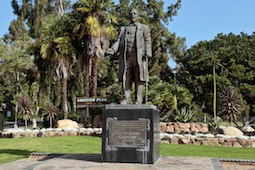 After the dust-up in spring 2012 about replacing most of Griffith Park’s Crystal Springs picnic area with two "youth baseball" fields, there was a period of relative silence. Local media had relished a disagreement that was often framed as tree-hugging curmudgeons versus kids longing for a place to play baseball.
After the dust-up in spring 2012 about replacing most of Griffith Park’s Crystal Springs picnic area with two "youth baseball" fields, there was a period of relative silence. Local media had relished a disagreement that was often framed as tree-hugging curmudgeons versus kids longing for a place to play baseball.
At length, the story went off the radar. But, behind the scenes, promoters of Little League type baseball, along with a certain L.A. City councilmember, had not given up on their attempt to snag Proposition K money (a competitive grant of $500,000) to replace most of the picnic area of Crystal Springs with two baseball fields.The Sierra Club's Angeles Chapter opposes the use of Crystal Springs for ball fields.
A Draft Environmental Impact Report (DEIR) was made public in October. Here is a brief summary: Funding from Proposition K (“L.A. for Kids”) and the Quimby Act would be used to build two youth baseball fields—accompanied by the usual dugouts, bleachers, warm-up areas, scoreboards, security lighting, landscaping and fencing—on a 4-acre site now used as a picnic and free-play area. To accommodate the ball fields, “up to 49 trees" would be removed. Included would be a huge, heritage sycamore. Removal of mature trees also means removal of habitat for birds, rodents and insects. Seven picnic tables would be “relocated.” The loop driveway would be truncated. Construction is expected to take two years.
Picnic area is a recreational use too
The DEIR for the ball fields project says its objective is to provide recreational programs “based on the needs of the community.” Which community is that? What about the community that consists of thousands of families who rely on and heavily use the Crystal Springs picnic area and have done so for half a century? The DEIR talks about “high quality, affordable recreation programs for youth in the area, especially at risk boys and girls.”
But Crystal Springs already provides affordable (free) passive recreation for families in the area, many of them Latino, most without backyards or easy access to green open space. These are the very people Colonel Griffith had in mind when he gave land to the City of L.A. as a place of respite for “the plain people,” who would need to escape from the noise and pollution of the surrounding city.
The ball fields project will benefit the few at the expense of the many. It will continue the national trend which Robert Reich calls “the decline of the public good.” In his book "Beyond Outrage," Reich points out that, “much of what’s called ‘public’ today is increasingly private.” These ball fields will be available only to children who are organized in youth baseball leagues. When baseball season ends, or when no one reserves them, the ball fields will be unavailable. They will be surrounded by chain link fences with locked gates. Most of the time, they will be closed, as is Pote Field (also in Crystal Springs). Four more acres of open green space in Los Angeles will be gone. And, when the bulldozers roll in, Crystal Springs picnic area and its users—humans and wildlife—will be out of luck.
Hearing held in November
A “workshop and hearing” meeting to present and discuss the DEIR was held on Nov. 20. L.A. City’s Bureau of Engineering, which will build the ball fields, conducted the meeting. Attendees were allowed 1 minute each to tell whether they supported or opposed the Crystal Springs location for the ball fields. Many who wanted to speak did not get a chance to do so before the meeting ended.
Proponents, many of whom brought their children, said more baseball fields for kids are needed. Opponents spoke about the trees that would be destroyed, the wildlife corridor that would be disrupted, and the users who would be displaced. Some argued that the Atwater site, proposed as an alternative location, would be better.
George Grace, founder of the Griffith Park Natural History Survey, has asked why the Ferraro Soccer Field area was not included as an alternative. This location is 23 acres and has the potential to host a complete sports complex. Why was this area not considered? Grace suspects that “Ferraro is not the high profile location where naming rights will be extremely valuable.”
Public comment period on the ball fields DEIR ends Dec. 17. Please email Maria Martin of the Bureau of Engineering: Maria.Martin@lacity.org. Copy District 4 Councilman Tom LaBonge: councilmember.LaBonge@lacity.org. You can also sign the Friends of Griffith Park petition to Save Crystal Springs.